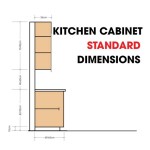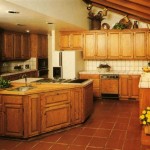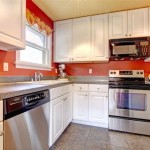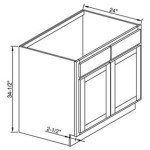Are Beige Kitchen Cabinets In Style? A Comprehensive Overview
The question of whether beige kitchen cabinets are "in style" is not a simple yes or no. The concept of "style" is inherently fluid, influenced by prevailing design trends, individual preferences, and the overall architectural context of a space. A more nuanced approach involves examining the enduring qualities of beige, its historical presence in kitchen design, and its current relevance in the face of competing color palettes and design philosophies.
Beige, often described as a pale brown or a light tan, occupies a neutral space on the color spectrum. This neutrality is both its strength and its potential weakness. It provides a versatile backdrop that can be easily adapted to various design schemes. However, it can also be perceived as bland or uninspired if not implemented thoughtfully.
Understanding the cyclical nature of design trends is crucial. Colors and styles that were once considered outdated often resurface with renewed appeal, albeit with reinterpretations and modern adaptations. Beige, having been a prominent color in kitchen design for several decades, is currently experiencing a resurgence, not as a singular dominant force, but as a versatile component within broader design strategies.
The contemporary application of beige kitchen cabinets frequently involves pairing them with contrasting elements. This could include bolder accent colors in the backsplash, countertops, or hardware. Alternatively, beige cabinets can be used to create a calming and sophisticated atmosphere when combined with other neutral tones and natural materials.
To adequately address the question of beige cabinet style relevance, it's essential to consider specific aspects: its versatility, its ability to create distinct aesthetics, and its presence in current design trends.
Versatility of Beige in Kitchen Design
Beige's inherent versatility is a primary reason for its enduring presence in kitchen design. Unlike bolder color choices that can quickly become dated or overwhelming, beige offers a subdued and adaptable base. It serves as a neutral canvas, allowing other elements in the kitchen to take center stage. This translates to significant flexibility when choosing appliances, countertops, flooring, and decorative accents.
Consider the possibilities: a beige kitchen with dark granite countertops and stainless steel appliances evokes a classic and sophisticated feel. Conversely, beige cabinets paired with butcher block countertops, a farmhouse sink, and pastel-colored accessories create a warm and inviting country-style kitchen. Furthermore, when combined with sleek quartz countertops, minimalist hardware, and geometric tile backsplashes, beige can seamlessly integrate into a contemporary design.
The undertones of beige also play a critical role in its versatility. Beiges with warmer undertones, leaning towards yellow or gold, project a sense of warmth and comfort. Cooler beiges, with hints of gray or green, offer a more sophisticated and modern aesthetic. The choice of undertone should align with the desired overall ambiance of the kitchen and complement the existing architectural features of the space.
The finish applied to the cabinets also affects the perception of beige. A high-gloss finish can create a more modern and reflective surface, while a matte finish adds a touch of understated elegance. Distressed or antiqued finishes can enhance the rustic or farmhouse charm of beige cabinets.
Ultimately, the versatility of beige lies in its ability to adapt to various design styles and color palettes. It is not a static color but rather a flexible foundation upon which to build a cohesive and personalized kitchen design.
Creating Distinct Aesthetics with Beige Cabinets
Beige cabinets are not limited to a single aesthetic. They possess the ability to contribute to a wide range of design styles, from traditional to contemporary. The key lies in the careful selection of accompanying elements, such as hardware, countertops, backsplashes, and accessories.
For a traditional kitchen: Pair beige cabinets with raised-panel doors, ornate hardware in brass or antique bronze finishes, and natural stone countertops like granite or marble. A detailed backsplash featuring intricate tile patterns can further enhance the traditional look. The overall effect is one of timeless elegance and sophistication.
For a farmhouse kitchen: Opt for shaker-style beige cabinets, butcher block countertops, and a farmhouse sink. Open shelving can display rustic pottery and vintage kitchenware. A subway tile backsplash and natural wood accents complete the farmhouse aesthetic, creating a warm and inviting atmosphere.
For a contemporary kitchen: Choose sleek, minimalist beige cabinets with flat-panel doors and simple hardware in stainless steel or brushed nickel finishes. Quartz countertops provide a clean and modern look. A glass or geometric tile backsplash adds visual interest. The overall design emphasizes clean lines and functional simplicity.
For a transitional kitchen: This blending of traditional and contemporary elements allows for combining beige cabinets with a mix of materials and styles. For instance, pairing shaker-style beige cabinets with quartz countertops and a subway tile backsplash creates a balanced and timeless aesthetic. Mixing metal finishes in the hardware and lighting fixtures can further enhance the transitional look.
The ability of beige cabinets to contribute to diverse aesthetics is not merely a matter of adding accessories. It hinges on a cohesive design strategy that considers the proportions, textures, and overall balance of the space. A well-designed kitchen with beige cabinets is not simply a collection of individual elements but a harmonious composition that reflects a specific style and personality.
Presence of Beige Cabinets in Current Design Trends
While bold colors and statement pieces regularly capture attention, beige cabinets maintain a quiet but persistent presence in contemporary kitchen design. Their appeal lies in their ability to create a sense of calm and sophistication, which is particularly valued in today's fast-paced world. Furthermore, beige seamlessly integrates with several emerging design trends.
Natural materials are experiencing a significant resurgence in popularity. Beige cabinets provide a neutral backdrop that allows the natural beauty of wood, stone, and other organic materials to shine. Consider the combination of beige cabinets with a natural stone backsplash, such as travertine or slate, or with butcher block countertops made from sustainably sourced wood. These pairings create a warm, inviting, and earthy atmosphere.
Minimalism continues to influence kitchen design, emphasizing clean lines, uncluttered surfaces, and functional simplicity. Beige cabinets, with their understated elegance, align perfectly with this aesthetic. By minimizing ornamentation and focusing on essential elements, beige cabinets contribute to a sense of spaciousness and calm.
Biophilic design, which seeks to connect people with nature, is another prominent trend. Beige cabinets, with their earth-toned hues, can be incorporated into biophilic designs by pairing them with plants, natural light, and organic textures. The result is a kitchen that feels connected to the outdoors, promoting well-being and relaxation.
Greige, a blend of gray and beige, has become a popular color choice for kitchen cabinets. This sophisticated neutral offers a cooler alternative to traditional beige while retaining the versatility and adaptability of its beige counterpart. Greige cabinets work well with a variety of countertop materials and backsplash designs, making them a versatile option for contemporary kitchens.
The continued presence of beige cabinets in current design trends indicates a shift towards creating kitchens that are not only aesthetically pleasing but also functional, comfortable, and conducive to well-being. While bold colors may come and go, the enduring appeal of beige lies in its ability to create a timeless and versatile space that can be enjoyed for years to come.
Ultimately, the question of whether beige kitchen cabinets are "in style" depends on a broader understanding of design principles and individual preferences. Beige is not simply a color but a versatile tool that can be used to create a wide range of aesthetic styles. Its enduring presence in kitchen design reflects its adaptability, its ability to create a sense of calm and sophistication, and its seamless integration with current design trends. The enduring popularity of beige suggests it is less a fleeting trend and more of a reliable component in the broader landscape of kitchen design.

You Have To See These Gorgeous Beige Kitchen Cabinets Edward George

Beige Kitchen Cabinets A Comprehensive Guide Oppein

Beige Kitchen Cabinets A Comprehensive Guide Oppein

You Have To See These Gorgeous Beige Kitchen Cabinets Edward George

Modern Beige Cream Kitchen Cabinets A 2024 Trend Decorcabinets Com
:max_bytes(150000):strip_icc()/5.TheRealShakerKitchen-deVOL_LOW-RES-fa5078274d2a4bf6b25531fbdb179e2e.jpeg?strip=all)
24 Beige Kitchen Cabinets That Make A Change From White

10 Beige Kitchens That Prove This Neutral Back For 2025 Homes And Gardens

Beige Kitchen Designs For Every Style

Eight Beige Kitchens With Serene Style Networx
Kitchen Cabinet Color Trends 2024 10 Desirable Colors For The Heart Of Home








